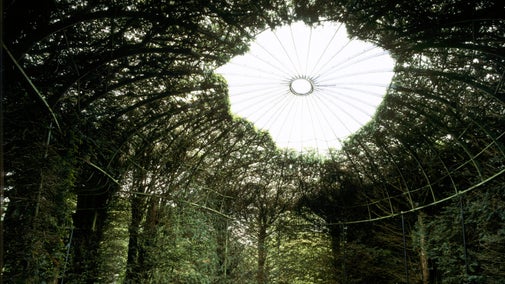
Discover more at The Argory
Find out when The Argory is open, how to get here, the things to see and do and more.

Discover the history of The Argory, from bridges and barrel organs, to an incredible treasure trove of letters and photographs.
The Argory was built 1820-24 for Walter MacGeough Bond who, in 1822, commissioned James Davis to build him a large finger organ with barrels for the lobby on the first floor of his new home.
Davis retired before beginning work and the contract passed to James Bishop, who completed the organ by September 1824.
Following this, the lobby became a space for the family to gather for morning and evening prayers, as plans to build a small chapel in the grounds of The Argory were never completed.
Samuel Wesley, son of the great hymn writer Charles and nephew to John Wesley, founder of the Methodist Church, was employed to consult on the music to be pinned onto the barrel.
The organ originally had six barrels but only three remain today. The missing barrels may have been destroyed in a fire that gutted the north wing of the house in 1898.
Plans were later drawn up to remove the organ and brick up the space to create a bathroom as part of the installation of hot water and heating systems. Thankfully these plans were never carried out and the organ remains intact.
The barrels can now only be played on special occasions but you’re invited to play the finger element during the tour.

The doomer Cabinet is regarded one of the most popular pieces of furniture at The Argory. By tradition, the ebony cabinet, with its extraordinary auricular cresting and mother-of-pearl inlaid flowers, had been thought to have been made in India and brought to Northern Ireland in the mid-nineteenth century. As Simon Jervis has shown, however, it is actually Dutch and, based on its close resemblance to a piece at the Rijkmuseum in Amsterdam, can be dated around 1640-50. Reinier Baarsen confirmed the attribution to Herman Doomer in his 2018 exhibition catalogue, because of the high quality of the piece
The Doomer Cabinet was on vacation in 2018 to Amsterdam where it was exhibited at the Rijksmuseum. It's now back on display in the Organ Lobby at The Argory.

The National Trust acquired the house in the late 1970s, along with all of the furnishings and a large collection of letters, photographs, documents and diaries.
The McGeough-Bond family were very enthusiastic in their correspondence. In 1937, Lady Bond sent 36 letters to her son, who was affectionately known as Tommy. When you consider that this equates to a letter – often several pages in length - roughly every ten days, and that he wouldn’t have been her only correspondent, this seems rather remarkable.
The family wrote about much the same things that we might discuss today on instant messaging or social media. Health and the weather crop up most often, along with news of their activities, updates on friends and the extended family, and of course, news about the house and grounds through the changing seasons.
An excerpt from a letter written by Mr Torrens, a servant at The Argory, sent in March 1937 describes a storm at the house.
– Mr Torrens, servant at The Argory, March 1937
In winter, you can often find a special stillness around The Argory, something perfectly encapsulated by Sir Walter in a letter to his son, upon his return to the house:
– Sir Walter, The Argory
Before Bond Bridge was built, a ferry crossed the river that was operated by a local lady named Maggie Maguire. Maggie lived in River Cottage which is now privately owned on the far side of the river.
The ground at Bond’s Bridge and the river path formed part of the original Argory estate, which was given to the National Trust in 1979. Today, the car park and jetty at Bond’s Bridge are reserved for local fishermen and may not be used by walkers to access the estate and walks.
Please use the main entrance to The Argory and follow the River Walk in order to view the bridge.

Tower clocks have been a part of human history for centuries and have played an important role in communities around the world. This is what makes the clock tower at the Argory more than just a timepiece. Clock towers were known as a symbol of community and identity, and they served as landmarks and gathering places for people.
The Argory clock tower structure, cupola, has an eight-day striking turret clock. The clock tower was made by Waugh and Son of Dublin. Waugh worked in Armagh prior to the move to Dublin in 1805 and was commissioned to make the iconic feature of the courtyard.
When you visit the Argory enjoy a coffee in the courtyard and take in the beautiful views of the Clock Tower. Why not imagine yourself in the 1800s without a watch, using the clocktower to plan your day.
Clock Tower pin badges are available in the visitor's reception.

Find out when The Argory is open, how to get here, the things to see and do and more.
Discover some of the important conservation work that has taken place at The Argory, including conserving rare acetylene lighting fixtures and fittings.

Discover all The Argory has to offer, from exploring the house to the out houses and then to the seasonal highlights in the garden.

Learn about people from the past, discover remarkable works of art and brush up on your knowledge of architecture and gardens.

Explore the objects and works of art we care for at The Argory on the National Trust Collections website.
